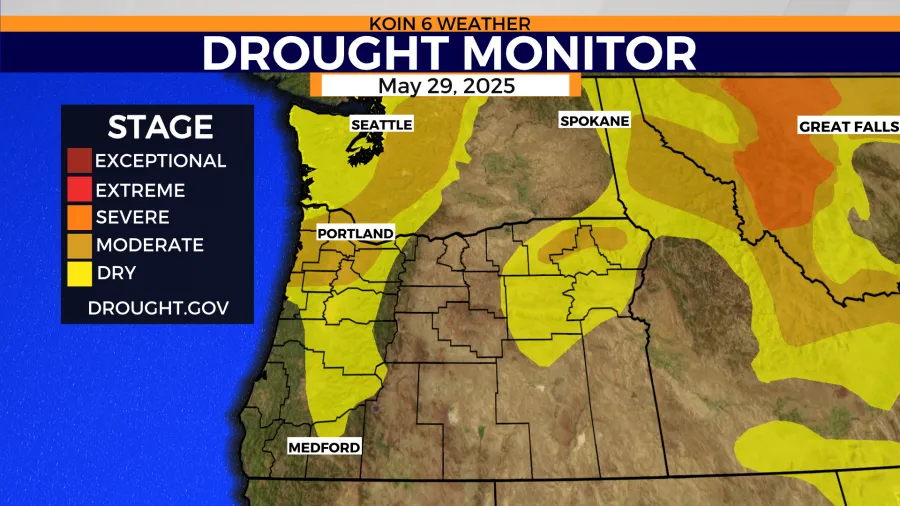Portland Weather: Drought and Rising Temperatures Raise Wildfire Concerns
The state of Oregon, particularly the Portland area and the Willamette Valley, is currently experiencing a significant shift in weather patterns, commanding attention as temperatures rise and drought conditions deepen. Forecasters have predicted that Portland will see some of the hottest temperatures of the year, with highs soaring into the 80s and 90s this week. While some may welcome the warmth, these soaring temperatures are also raising alarms about drought and the potential for wildfires.
Current Weather Trends
According to the National Weather Service, Portland’s temperature is set to jump again on Friday, reaching a high of 86 degrees Fahrenheit. This spike is tied to a pattern of unusually warm weather impacting not just Portland, but much of the Willamette Valley. With highs predicted to flirt with the 90-degree mark, residents may be tempted to enjoy outdoor activities over the weekend. However, a cool-down is expected, with temperatures forecasted to drop into the 70s by Saturday.
Weather Patterns Over Recent Weeks
Over the past few weeks, Oregon has faced sharply fluctuating weather conditions. An extended period of rainfall in early September led many to believe that drought conditions might abate. However, recent dry spells have reversed much of that sentiment, with numerous weather models indicating a return to drought status in many regions. The state-reported precipitation levels have decreased significantly in October, leaving reservoirs and rivers at lower-than-usual levels.
Drought Conditions in Oregon
As of mid-October, the U.S. Drought Monitor indicates that portions of northwest Oregon are classified under Moderate Drought, with some areas facing Severe Drought conditions. The fact that the drought has returned indicates a worrying trend for farmers, wildlife, and the broader ecosystem. With less moisture in the ground, vegetation dries out, creating the perfect conditions for wildfires.
The Impact of Drought on Agriculture
Farmers in the Willamette Valley, known for its rich agricultural outputs, are particularly vulnerable to these changes. As crops require consistent moisture to thrive, the lack of rain poses challenges for key produce such as fruits and vegetables. Some farmers have reported lower yields, forcing them to make difficult decisions regarding irrigation and water usage.
Community Response to Drought
The local government and community organizations are mobilizing to manage water resources more effectively. Conservation measures have been put in place, encouraging residents to reduce water consumption.
Wildfire Threat on the Rise
As temperatures rise, so does the potential for wildfires. In a typical year, late summer and early fall are already known for their wildfire risks, but the presence of drought exacerbates the likelihood of wildfires breaking out. With vegetation, especially grasses and shrubs, becoming parched and dry, even a small spark can lead to devastating consequences.
Preparedness and Precautions
Emergency services and fire departments across Oregon are issuing warnings to residents about the rising wildfire threat. Efforts have been redoubled to ensure that communities are prepared and educated on how to handle wildfire emergencies. Authorities are also working to reduce fuel loads in forests and other natural areas, aiming to decrease the intensity of potential wildfires. Public alerts are being implemented to inform citizens of heightened risks, urging them to follow safety protocols during burn bans and outdoor activities.
Advice for Residents
As the weather remains hot and dry, residents in and around Portland are encouraged to take the necessary steps to protect themselves and their property. Some recommendations include:
- Limit outdoor activities during peak heat hours, typically between noon and 4 PM.
- Stay hydrated and keep an eye on vulnerable populations such as the elderly and children.
- Familiarize yourself with evacuation routes and emergency plans in the event of a wildfire.
- Be cautious with outdoor activities that could ignite a fire, like grilling or using fireworks.
Looking Ahead
Looking ahead, weather models suggest that Oregon may see continued variations in temperatures and precipitation. While immediate forecasts indicate a cool-down, these changes offer only temporary relief from drought and wildfire concerns. Longer-term forecasts will need to be analyzed to assess how climate patterns might affect conditions in the months to come.
Conclusion
Portland’s weather is an intricate tapestry of highs and lows, reflecting broader climatic changes impacting not just the region but the entire Pacific Northwest. With drought worsening and wildfire threats looming, it is essential for both residents and local authorities to stay informed and prepared. As Oregonians brace for what may be a challenging autumn, the need for community cooperation and proactive measures becomes more vital than ever. Let’s hope that long-term solutions to water management and fire safety can be implemented to navigate these trying times efficiently.







